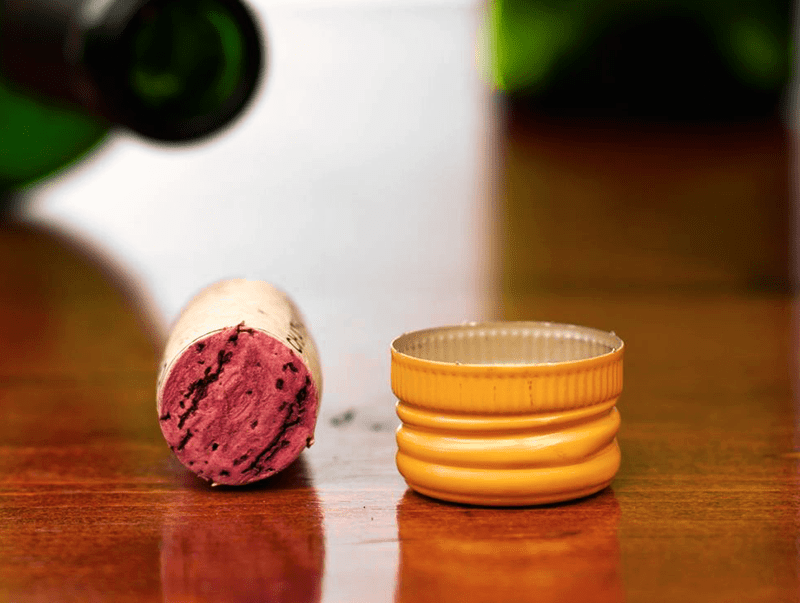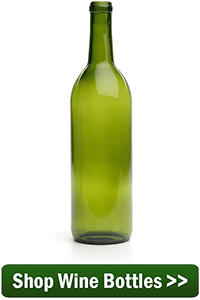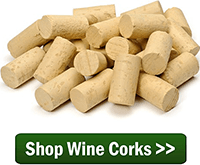 Here’s a great question from one of our customers about using wine cork vs screw cap wine bottles. I thought this would be great to share!
Here’s a great question from one of our customers about using wine cork vs screw cap wine bottles. I thought this would be great to share!
—–
I live very close to a winery and use their used wine bottles for bottling my homemade wines. Sometimes they use cork wine bottles and screw cap wine bottles for the same wine. Do you know why this would be?
Name: William B.
State: Virginia
—–
Hello William,
Thank you for such a great wine making question. I’ll see what I can do to clear up why you would see a winery use both wine cork and screw cap, and more specifically, why a winery would use both on the same batch of wine!
Here’s the basic pros and cons of using one over the other.
Using screw cap wine bottles will extend the life of a wine. The screw caps make a perfect seal, not allowing any air to seep into the wine. This perfect seal extends the wine’s shelf-life. You could have a screw cap wine be fantastic for 7 or 8 years that otherwise would have only been at its best for 4 or 5 years under cork.
But this “perfect seal” also extends the amount of time the wine needs to mature into a drinkable or – in the case of a winery – salable wine. In fact, it could take up to twice as long for the wine’s maturation process to plateau. This means more inventory sitting in the racks that can’t be sold.
On the other hand, wine corks facilitate the aging process a little more freely. A natural cork allows minuscule amounts of air to pass by it. Over time, this trace amount of air will facilitate the wine’s ability to age and become more drinkable sooner. The downside is that the entire life of the wine will be shortened. So while it will be ready for market sooner it will not last as long on the shelf.
 It is possible that the winery corked some of their wine to sell earlier and used screw caps on some to sell later. In effect, this would time out the aging of the wine so that there would be more wine reaching peak maturity over a longer period of time. However, this is only speculation on my part.
It is possible that the winery corked some of their wine to sell earlier and used screw caps on some to sell later. In effect, this would time out the aging of the wine so that there would be more wine reaching peak maturity over a longer period of time. However, this is only speculation on my part.
There used to be great debates over the use of screw caps. Whenever someone saw a wine under a screw cap they automatically thought: cheap or low-grade wine. That’s absolutely not the case today. Whether a winery uses wine cork vs screw cap is a matter of wine treatment, a calculation of sorts that has nothing to do the the aesthetics and everything to do with maximizing the quality of the wine.
In general, you will discover that lighter-colored wines with less body, such as a Zinfandel Blush or a Chablis are more likely to be under screw cap. This is not because the wines are of low quality, but rather, because the wines are anticipated to fully maturate more quickly than most and do not need the air seepage the natural wine corks provide. They need the air-tight, screw cap wine bottles to slow the process down.
This principal of controlling how a wine ages can be incorporated into home winemaking as well.
Whenever you are ready to bottle a wine, first think about how long the wine could potentially be shelved before it is all consumed: 1 year, 3 years, 3 months! Think about the color of the wine. Is it a white wine that is at risk of oxidation? Are the grapes used to produce the wine known for producing complex, rich wines that can take advantage of abundant aging, or are the grapes known for being crisp, fresh and quickly aging?
 When you consider such factors you can start to come up with your own plan and know how to handle the question of wine cork vs screw cap. If your wine’s do not sit around long, go with the wine corks so they can get some aging in. If your batches of wines tend to sit around for years before being consumed go with screw cap and so on with other considerations.
When you consider such factors you can start to come up with your own plan and know how to handle the question of wine cork vs screw cap. If your wine’s do not sit around long, go with the wine corks so they can get some aging in. If your batches of wines tend to sit around for years before being consumed go with screw cap and so on with other considerations.
William, I hope this answers the question you had about wine cork vs screw cap. As you can see, there is definitely a reason for using one over the other.
Happy Winemaking,
Ed Kraus
—–
Ed Kraus is a 3rd generation home brewer/winemaker and has been an owner of E. C. Kraus since 1999. He has been helping individuals make better wine and beer for over 25 years.

Another point here is storage. You can store screw caps vertically in the case, but corked bottles have to be stored horizontally. I use screw caps for this very reason.
One of the best explanations I have read about screw-tops vs corks
I think you are absolutely right, that is why I use both caps and corks in making my own home made wine. I enjoy reading your news letter over the years, in fact it help mje to take a 1st place in rhe NCState Fair competition in 2013. Maurice H Oliver
How about using the capsules to top off your corked wine. Doesn’t that keep the air out a little more than just a cork? I use the cpsules all the time and I can’t say I’ve had a bad bottle of wine after 8 years
I tend to agree with Mr. Partsch. Whenever possible I use both the cork & cap. Aging of my wine is not a factor, as my wine is consumed too rapidly.
My brother in law often saves screw cap bottles and reuses them. How many times can a screw top be used until it is ineffective?
Bob, the answer to your question depends on the screw cap. We carry metal screw caps that we do not recommend reusing. We also carry plastic poly seal caps that are reusable many times over.
I reuse screw caps on San Pellegrino glass bottles for my wines. To insure that I have a good seal I give the sealed bottle tops a dip in molten sealing wax.
Where do Zorks fall in this category?
Tony, the Zork Corks will fall along with the screw caps because the form a perfect seal.
Are the “plastic” bottles with screw on caps good to use too??
Clercy, there are getting to be more people that use plastic wine bottle with screw caps.
I use original cork, not synthetic corks. I have purchased two bottles of Riesling wine made in Germany. They have screw caps were before they would use cork. I did not notice they switched to screw top. I was completely disappointed, no flavor, completely flat. Although I enjoyed this white wine, I prefer reds. If I buy a bottle in the store, I check the cork, if not natural, I will replace, with natural cork. I am very careful when I do this transition.
I made a Cabernet Sauvignon, prior to bottling, I tasted, totally superb.
Any wine with a screw top, I just walk on by.
I certainly do not recall good wine with screw tops.
About 50 yrs ago, I believe that Thunder Bird wine had a screw top, Mogen David also.
How about the wines that were made back in, the 15’s, 16’s & 17’s hundreds, and so on.
I have found that when I re-use screw cap bottles, the caps sometimes don’t seal well, even when screwed down tight. But you can’t tell until they start to leak. And when I’ve tried buying good quality steel replacement caps, many bottles have a shoulder that prevents the new cap from going down all the way to make an effective seal. I got tired of bottles leaking and worrying about spoilage. I have recycled all my screw cap bottles and went to corks. Corking is easy, with a floor corker. Pay attention to cork quality, if you plan prolonged bottle aging. Unfortunately, used wine bottles for corking are getting harder to find, because more and more commercial wineries are going to screw caps.
For a non-traditional approach, 750 ml crown cap bottles are great for indefinite long term storage. Caps are very cheap, and a bench capper makes the process fast and easy. For home use, I also like swing top bottles, but they are too expensive to give away. Both can be stored upright.
Wine with synthetic corks can be shelved up-right.
I also believe corks were first use to prevent the bottle from exploding and just ejecting the cork if fermentation was incomplete.
Good summary about screw cap vs cork. However, what is missing is where do we get replacement screw caps for the Stelvin closure bottles. The 28 mm screw caps for sale on your site, fit those screw top bottles you sell on your site, but most of the “throw away” commercial wine bottles are the Stelvin closure bottles. When I see a commercial bottle with a screw cap, it is (almost) always a Stelvin closure. I didn’t find any bottles or caps like that on your site. Do you plan on stocking those aluminum caps so we home wine makers can reuse Stelvin top bottles?
Walt, we are sorry, we do not plan to carry Stelvin caps. We do not have any information on where you can find them either.
For homemade wine I would recommend the screw cap 750 ml bottles:
1) storing your wine in carton boxes is huge space saver
2) no need wine rack
3) it is easy to re-bottle the wine clear off sediment that appeared on the bottom of vertically stored screw-top bottle
4) no oxygen penetration gives longer life
5) stored in boxes wines are not affected with temperature and light condition changes
And you do not have to worry about the cork getting dry. I would say the corks are yesterday’ s method. The screw caps bottles are way more convenient. You need to know a few little secrets how to keep your screw tops in good shape to re-use same bottles for numerous of years. Your wine will never get spoiled, oxidized.
I store my corked bottles in the cartons, upside down. Only problem is being careful to not let the bottles crash into each other when pulling a bottle from a partially empty carton and any sediment collecting at the neck of the bottle.
I do however wish that I had been using screw tops on some of all my wines, some of the 3 & 4 year olds are getting past prime. Turned down and threw out too many screw type bottles.
I use reusable plastic corks but I age the wine in bulk for a while before bottling. Seems to work fine . Means an extra racking at the end of fermentation but an easy thing that produces acceptable results. That and careful hydrometer readings around the added sugar issue works out fine.
Another viewpoint. I have 5 gallons of Blackberry wine. I put it in 16 oz beer bottles and put a bottle cap on it. I then dipped the top in wax. Any feed back??
Dave, while you can certainly bottle your wine in capped beer bottles, it does affect the aging process especially if you are also using sealing wax. For more information, please take a look at the article posted below.
Bottle Wine In Beer Bottles
https://blog.eckraus.com/can-i-bottle-my-wine-in-beer-bottles
I have been using flip top bottles for 20 years with almost no problems. Sometimes I bottle before fermentation is complete accidentally. Most of the time I like the carbonation.The only time a bottle broke in storage seams to have been because it was square.
Adding to my earlier comments screw cup vs cork:
1) with the beginning of supermarkets time in 70-th the era of cork was over. The new way of selling wines required some protection to wine from spoiling and turning into vinegar due to light and temperature of storage changed completely. It was time for sulfites!
2) Sulfites kill the life of wine, so not need anymore to allow oxygen come into wine thru cork. The oxygen into dead (with sulfites) wine works opposite, speeding the oxidation of wine.
3) The screw cup allows you to fill the bottle up to the very top. In cork sealed bottle you have one inch of air between wine and cork. It is bad for wine.
4) In tropical climate (my case) you must keep your wine without letting air penetrate your cork. My friend prefers to use cork to seal the bottles – he has 50% of his wine oxidized after 3 years in storage. My suggestion him to increase his drinking he accepted as a jock. What would you say? I would say good bye to cork forever
Please discuss how heat shrink plastic sleeve/caps affect aging. I’m a newbie winemaker, planning on using natural corks. Am wondering about losing quality of the wine overtime (if I don’t drink or give it away fast enough). Would putting a heat shrink plastic sleeve stop the aging (since wine wouldn’t be able to breathe)?
Carol, using heat shrink capsules on the wine bottles will slow down the aging process. The wine will still age, it just takes a little longer. While these sleeves do add decoration to the wine bottle they also have a couple of other more practical functions. They help to eliminate the growth of mold and bacteria on the outward exposed surface of the cork while it is in storage. And, they also help to keep the cork in place, should it decide to push out of the bottle.
As Italians we used to make our wine in the wine cellar the same way it has been done for centuries. We simply crushed the grapes (Either Malbec in the spring or Cabernet or a mixture of Elegante & Moscato in the fall) and placed the crushed grapes and juice in an upright barrel with the top off. We let it sit until the inherent sugar burned off (we never added sugar) and the skins/juice cooled. Usually about a week or so. Then we would press and put the wine into a horizontal barrel capping off with a waxed seal. About six months later we would rack the barrel and again let it sit for about a year after which we would rack it again and so forth. At that point we would bottle the wine using a synthetic cork. The wine would be clear and excellent for homemade wine. Usually that barrel would be drunk over the next year.
One year we made the Elegante / Moscato in the fall and after a year we began drinking that particular wine early. It was only about a year old. One evening I had filled a half gallon whiskey bottle with that particular wine and left it sitting in the kitchen with the screw top on. I heard a loud pop after which I ran to the kitchen and found a large part of the heavy glass whisky bottle had blown out and was laying on the table. I surmised that the wine was still “alive” and the screw cap didn’t allow the air to escape the way a cork would have. Immediately I thought “so that’s why only cheap wines use screw caps. They must have to kill the wine to be able to use a screw cap”. That’s what I thought at the time. Back then all of the cheap wines that used to come in gallon bottles used screw caps. All of the better wines used cork.
So logically It seemed to me that the wine had to be “killed” in some way in order to take a screw cap because if it is still “alive” the bottle would probably explode somewhere down the line. Then I learned that some wines were homogenized which again seemed like it had something to do with killing the wine and now I’m told that almost all wines are run through some sort of fining having to do with either egg whites or a milk residue.
So I understand why a winemaker would want to keep the wine stable so that it can be exported without consequence but at what price. Therefore my question is what is done to the wine these days to allow for the usage of screw tops instead of cork? Again it seems to me that the wine has to be “killed” in order to allow that to happen. What am I missing?